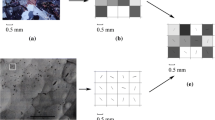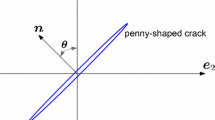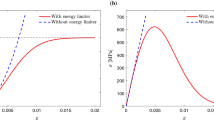Summary
A phenomenological model is developed to represent failure in intact media as a consequence of shear-band formation. A stepped arrangement of connected flaws is assumed to be distributed within a planar shear-band inclined with respect to the applied deviatoric stresses. The flaws within the shear-band isolate a series of wedges that transmit tractions across the pre-failure zone. Gross stress transmission is controlled by static equilibrium with spatial stress inhomogeneity modulated through the distribution of flaws in the continuum adjacent to the shear-band. Under increased confinement, flaw closure beyond the shear-band results in a more homogeneous transmission of normal tractions across the failure plane. This stress dependent transition is based on physical arguments, related to mean flaw closure, to yield a distribution coefficient,W, that is controlled by macroscopic flaw rigidity,B. The model is able to replicate the power law dependency of ultimate strength with confining stress that is commonly observed. The model is specifically calibrated against experimental data for Daye marble. The phenomenological coefficients describing the failure process appear as material constants.
Similar content being viewed by others
References
Batzle, M., Simmons, G., Siegfried, R. (1979) Direct observation of fracture closure in rocks under stress. EOS Trans. 60, 380.
Bieniawski, Z. T. (1966): Mechanism of brittle fracture of rock. CSIR Report RMEG 580, Pretoria.
Bombolakis, E. G. (1968): Photoelastic study of initial stages of brittle fracture in compression. Tectonophysics 6, 461–473.
Brace, W. F., Bombolakis, E. G. (1963): A note on brittle crack growth in compression. J. Geophys. Res. 68, 3709–3713.
Brace, W. F., Paulding, B. W., Scholz, C. (1966): Dilatancy in the fracture of crystalline rocks. J. Geophys. Res. 71, 3939–3952.
Brady, B. T. (1969a): A statistical theory of brittle fracture. Part I. Int. J. Rock Mech. Min. Sci. and Geomech. Abstr. 6, 21–42.
Brady, B. T. (1969b): A statistical theory of brittle fracture. Part II. Int. J. Rock Mech. Min. Sci. and Geomech. Abstr. 6, 285–300.
Dey, T. N., Wang, C.-Y. (1981): Some mechanics of microcrack growth and interaction in compressive rock failure. Int. J. Rock Mech. Min. Sci. and Geomech. Abstr. 18, 199–209.
Fairhurst, C., Cook, N. G. W. (1966): The phenomenon of rock splitting parallel to the direction of maximum compression in the neighborhood of a surface. In: Proc. 1st Int. Congress Int. Soc. Rock Mech. Liston, 687–692.
Fonseka, G. M., Murrell, S. A. F., Barnes, P. (1985): Scanning electron microscope and acoustic emission studies of crack development in rocks. Int. J. Rock Mech. Min. Sci. and Geomech. Abstr. 22, 273–289.
Griffith, A. A. (1921): The phenomena of rupture and flow in solids. Philosophical Transactions 221, 163–198.
Griffith, A. A. (1924): Theory of rupture. In: Proc. 1st Int. Congress on Appl. Mechanics, Delft, 55–64.
Hallbauer, D. K., Wager, H., Cook, N. G. W. (1973): Some observations concerning the microscope and mechanical behavior of quartzite specimens in stiff triaxial compression tests. Int. J. Rock Mech. Min. Sci. and Geomech. Abstr. 10, 713–726.
Hoek, E., Bieniawski, Z. T. (1965): Brittle fracture propagation in rock under compression. Int. J. Fracture Mech. 1, 137–155.
Janach, W. (1977): Failure of granite under compression. Int. J. Rock Mech. Min. Sci. and Geomech. Abstr. 14, 209–215.
Kranz, R. L. (1979a): Crack growth and development during creep in Barre granite. Int. J. Rock Mech. Min. Sci. and Geomech. Abstr. 16, 23–36.
Kranz, R. L. (1979b): Crack-crack and crack-pore interactions in stressed granite. Int. J. Rock Mech. Min. Sci. and Geomech. Abstr. 16, 37–48.
Liu, H. P., Livanos, A. C. R. (1976): Dilatancy and precursory bulging along incipient fracture zones in uniaxially compressed Westerly granite. J. Geophys. Res. 81, 3495–3510.
Lundborg, N. A. (1974): A statistical theory of polyaxial strength of materials. In: Proc. 3rd Int. Congress Int. Soc. Rock Mech., Denver, 180–185.
McClintock, F. A., Walsh, J. B. (1962): Friction on Griffith cracks in rocks under pressure. In: Proc. 4th U.S. National Congress on Applied Mechanics, Vol. 2, 1015–1021.
Nesetova, V., Lajtai, E. Z. (1973): Fracture from compressive stress concentrations around elastic flaws. Int. J. Rock Mech. Min. Sci. and Geomech. Abstr. 10, 265–284.
Peng, S. D., Johnson, A. M. (1972): Crack growth and faulting in cylindrical specimens of Chelmsford granite. Int. J. Rock Mech. Min. Sci. 9, 37–86.
Sholz, C. H. (1968a): Microfracturing, aftershocks and seismicity. Bull. Seism. Soc. Am. 58, 1117–1130.
Scholz, C. H. (1968b): Macrofracturing and the inelastic deformation of rock in compression. J. Geophys. Res. 73, 1417–1432.
Sokolinkoff, I. S. (1961): Mathematical theory of elasticity, 476 pp. J. Geophys. Res., 4237–4292.
Swain, M. V., Lawn, B. R., Burns, S. J. (1974): Cleavage step deformation in brittle solids. J. Mater. Sci. 9, 175–183.
Tapponnier, P., Brace, W. F. (1976): Development of stress induced microcracks in Westerly granite. Int. J. Rock Mech. Min. Sci. and Geomech. Abstr. 13, 102–113.
Timoshenko, S. P., Goodier, J. N. (1970): Theory of elasticity. McGraw-Hill, New York, 109–112.
Vutukuri, V. S., Lama, R. D., Saluja, S. S. (1974): Handbook on mechanical properties of rocks, Vol I, Trans. Tech. Publ. Clausthal.
Wang, T. F. (1982): Micromechanics of faulting in Westerly granite. Int. J. Rock Mech. Min. Sci. and Geomech. Abstr. 19, 49–64.
Wiebols, G. A., Cook, N. G. W. (1968): An energy criterion for the strength of rock in polyaxial compression. Int. J. Rock Mech. Min. Sci. and Geomech. Abstr. 5, 529–549.
Woronow, A. (1975): A new technique for determining the preferred failure angle of brittle rock. Int. J. Rock Mech. Min. Sci. and Geomech. Abstr. 12, 289–293.
Wu, F. T., Thomsen, L. (1975): Microfracturing and deformation of Westerly granite under creep condition. Int. J. Rock Mech. Min. Sci. and Geomech. Abstr. 12, 167–173.
Author information
Authors and Affiliations
Rights and permissions
About this article
Cite this article
Ouyang, Z., Elsworth, D. A phenomenological failure criterion for brittle rock. Rock Mech Rock Engng 24, 133–153 (1991). https://doi.org/10.1007/BF01042858
Issue Date:
DOI: https://doi.org/10.1007/BF01042858




